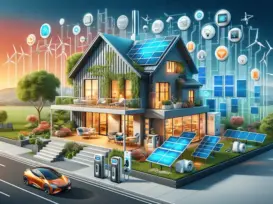Grus Home Energy - Electric Vehicle (EV) Charging
The Future of Fueling Up: Exploring the Advanced Landscape of Electric Vehicle (EV) Charging Technologies
The Future of Fueling Up: Exploring the Advanced Landscape of Electric Vehicle (EV) Charging Technologies
As the world increasingly turns its attention to sustainable energy sources, the electric vehicle (EV) market is expanding at a remarkable pace. With global initiatives to reduce carbon emissions and the rising costs of traditional fuels, EVs are not just a symbol of environmental consciousness but also a practical solution for the future of transportation. One crucial aspect of this burgeoning EV ecosystem is the technology behind EV charging— a field that is evolving rapidly to keep pace with the growing demands of drivers and the innovations in vehicle design.
The landscape of EV charging is diverse, encompassing a range of options that cater to different needs, lifestyles, and infrastructures. At the most basic level, EV charging can be broken down into three categories: Level 1, Level 2, and DC Fast Charging (DCFC). Level 1 charging utilizes a standard household outlet (110-120V) and is the most accessible form of EV charging, though it is also the slowest, often taking overnight or longer to fully charge a vehicle. Level 2 charging is faster, requiring a 240-volt outlet similar to what is used for heavy appliances at home, and can typically fully charge an EV in a few hours.
DC Fast Charging represents the cutting edge of EV charging technology. These high-power charging stations can add 60 to 100 miles of range in as little as 20 minutes, making them ideal for quick stops during long trips. However, the availability of DCFC stations is still limited compared to Level 1 and Level 2 options, particularly in rural or underdeveloped areas.
The evolution of EV charging is not just about speed. Connectivity and convenience are key components of the latest advancements. Smart charging stations can now be found in many urban areas, offering features like real-time availability status, reservation systems, and integrated payment options. Some are even equipped with energy storage systems to mitigate the demand on the electrical grid during peak times.
Wireless EV charging is another exciting development, although it’s still in the early stages of deployment. This technology allows for an EV to be charged by simply parking over an inductive charging pad, eliminating the need for plugs and cables. While wireless systems currently offer lower charging rates compared to their wired counterparts, they hold promise for a future of seamless, automatic charging.
Home-based charging systems are also improving, with the integration of smart home technology enabling EV owners to optimize their charging schedules based on electricity rates, reducing costs and further minimizing the carbon footprint associated with EV charging. Furthermore, bi-directional charging is emerging, allowing EVs to not only draw power from the grid but also supply it back, turning electric cars into mobile energy storage units that can provide power to the grid or a home during peak demand or outages.
The push for renewable energy integration with EV charging stations is gaining momentum as well. Solar-powered and wind-powered charging stations are being tested and implemented, contributing to the true potential of EVs for a zero-emission future. These green charging stations are expected to become more commonplace as the cost of renewable energy technologies continues to decrease.
In conclusion, the future of EV charging is one of innovation and anticipation. As the technology improves, the infrastructure expands, and the world becomes more interconnected, the act of “fueling up” an electric vehicle will become increasingly convenient, efficient, and environmentally friendly. From smart charging networks to wireless power transfer and renewable energy integration, the advanced landscape of EV charging technologies is set to revolutionize the way we think about driving and energy consumption for the years to come.
Blog, Smart Home Automation , February 17, 2024 , Electric Vehicle (EV) Charging, Energy Consumption Analysis, Energy Management, Energy Savings and Profit, Heat Pumps Optimization, Home Battery Storage, Renewable Energy Technologies, Smart Grid Technology, Smart Metering, Smart Metering Systems, Solar Panels Efficiency, Sustainability in Home Energy
©2025 All Rights Reserved. Grus IoT Co.,Ltd.
